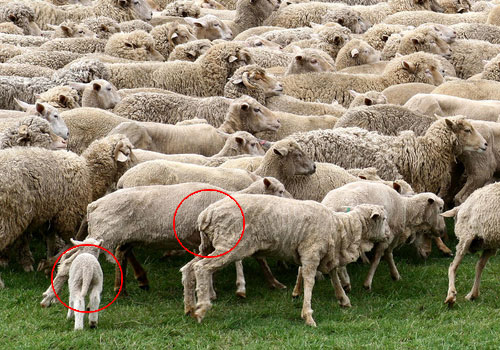Tail-docking is recommended to prevent blowfly strike in sheep. The Code of Practice states that the removal of the lower portion of the tail is to be done in lambs that are 2-12 weeks of age and can be done without anaesthesia.2 If the sheep are six months or older, pain medication must be given during the procedure.2
Current acceptable methods of tail-docking include:2
- cutting the tail with a sharp knife
- rubber rings/banding
- hot iron to sear off the lower tail
Removal of the lower portion of the tail means that less wool becomes stained with urine and fecal matter – this results in lower rates of skin infections and bacterial growth in the wool.1 Most importantly, the tail-docking procedure lowers the occurrences of flystrike in the breech area.1 When the tail remains intact and becomes dirty, it attracts blowflies to the sheep.1 Flystrike can occur in sheep that have been mulesed but still have intact tails, which means that both tail-docking and mulesing are needed in order to give the sheep the best possible prevention against breech flystrike1. Removal of the tail also means that the fleece of the sheep remain cleaner and results in less waste when shearing.1
There has not been a high level of controversy in the wool industry about tail-docking as there has been for mulesing, so there has not been much research into alternative methods.3 The main suggestion currently is to selectively breeding the Merino for shorter tails or cross-breeding with other sheep breeds that naturally have a shorter tail.1 As that breeding programs are not doing extensive research into producing a Merino with a shorter tail at the moment, tail-docking is still considered the recommended procedure to prevent flystrike.
Photo from Flickr user PhotoTina.
1 James, P.J. 2006. Genetic alternatives to mulesing and tail docking in sheep: a review. Australia Journal of Experimental Agriculture 46: 1-18
2 Primary Industries Ministerial Council 2006 Model Code of Practice for the Welfare of Animals – The Sheep, 2nd Edition. CSIRO Publishing, Collingwood.
3 Sneddon, J. and Rollin, B. 2010. Mulesing and Animal Ethics. J. Argric Environ Ethics 23: 371-386
4 WoolProducers Australia. 2007. About Wool. Available at:
http://www.woolproducers.com.au/about-wool/ Accessed Feb. 1 2012

